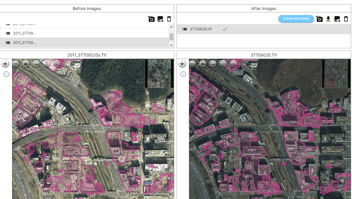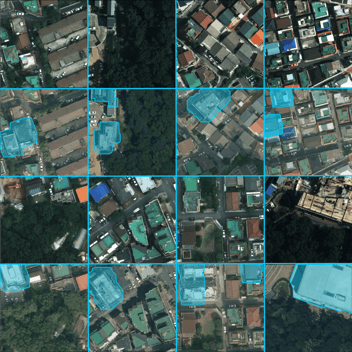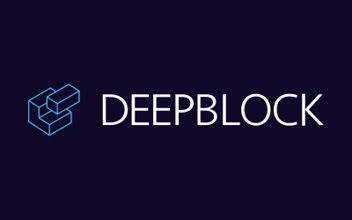Deep Block now offers change detection for remote sensing imagery.
The earth’s surface is constantly evolving through rampant urbanization, deforestation, re-forestation, flooding, fires, and other disasters, or even climate change impact. With an exponential amount of Earth Observation data at our disposal, there is now a plethora of information to measure those changes on a spatial and temporal (both short-term and long-term) scale.
Change Detection (CD) based on remote sensing technology is used to discover and identify discrepancies in ground objects using two (bi-temporal) or more (multi-temporal) images taken by the same type of sensor, usually Electro-optical (EO) or Synthetic Aperture Radar (SAR), at the same geographical location.
The recent advances in computer vision have enabled powerful Deep Learning-based change detection models. These models can take bi-temporal images as input and predicts “where” the change has occurred. Based on the inference result, a “change area” is created at a pixel level to highlight any environmental or situational changes, given a chosen threshold. This way, analysts only have to choose a temporal frame, a location, and the right algorithms to get immediate results.
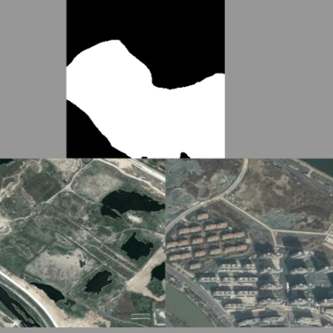
Image of the change area created from bi-temporal satellite imagery.
Improving on traditional change detection models.
Change detection techniques can be divided into two categories: traditional and AI-based.
Traditional change detection could be performed by different approaches, either through manual interpretation, algebraic transformation, or classification comparison, which provided great results but was based on expert knowledge, and was labor-intense and time-consuming. Other advanced changed analysis models or hybrid approaches were more intuitive but still laborious.
As AI-based approaches made their way into geospatial analytics, change detection techniques became more flexible, accurate, and superior when analyzing multi-temporal data and extracting high-level features.
A feature is a measurable piece of data in an image that makes a specific object unique (a specific shape with lines and edges, a distinct color), and distinguishable from other objects in the picture (e.g. a building). Feature extraction is one of the building blocks of computer vision and, in the case of change detection, the first step to get the abstract features from different inputs. This step is essential to create a “feature map” that can be compared through time, which is used to predict the “changed area”.
However, the design of AI-based change detection is a challenging process. Before recent advances in Deep Learning, change detection was a still tedious and lengthy process, solved through complex and handcrafted feature extractors. These methods also required expert knowledge each step of the way. Their accuracy was also impaired by variable factors such as climate variation, illumination conditions, satellite sensor shooting angles, and solar altitude angles.
In order to build a robust model for complex scenarios, change detection uses now similar advances already in action in image classification, semantic segmentation, and object detection. The goal is to solve most of the change detection limitations regarding blurry edges, small objects, as well as image scale and resolution variations.
For Constantin Stipnieks, Machine Learning Engineer at Deep Block, that is where the use of a Siamese network makes all the difference.
“Siamese networks are artificial neural networks working in tandem to compare inputs from different images. They are commonly used in face comparison but are proven to be game-changer for building high-performing feature maps for change detection. What makes this approach special is that the features taken from different temporal scales can now interact with each other in the Siamese network, to better match and fuse together.”
Constantin Stipnieks, Machine Learning Engineer at Deep Block.
This results in a more reliable method that consistently outperformed other well-tuned change detection models. The change detection model is now more tolerant to misalignment and luminosity variation, which reduces the need for pre-processing multi-temporal and heterogeneous images.
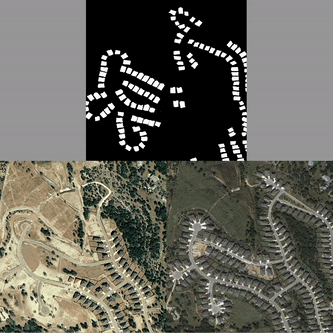
Animation of the change area created from multi-temporal satellite
imagery at different angles, illumination and resolution.
A growing range of applications for change detection models.
Change detection is seeing a growing variety of applications ranging from Intelligence, Surveillance, and Reconnaissance (ISR), environmental monitoring, disaster management, urban planning, and agriculture.
These changes can be predicted from the change in the ground object’s shape, size, location, and classification (purpose) over a defined period of time. This proves to be particularly useful in surveillance operations for air situation monitoring, maritime awareness, and strategic site monitoring. For example, the rapid expansion of an industrial complex, or the conversion of a civilian airport into a military base can be picked up by the algorithm and automatically flagged.
A visual and easy-to-interpret change detection map can indicate the addition or removal of buildings which is one of the main uses for urban and public space management, cadastral map update, illegal constructions detection, urban expansion monitoring, infrastructure monitoring, and building use classification change.
Land cover changes are typically reflected in climatology and hydrology, which makes change detection a great solution for resources and environment monitoring. Indeed, human-driven or natural environmental change can be detected on a macro scale to evaluate the results of climate change such as ice melt and coastal alteration. Focus analysis can also be conducted in forest monitoring to document deforestation or reforestation, illegal logging activities, and invasive species or infestation detection.
Natural disasters can also be detected and monitored in a relatively short period of time as they immediately impact populated areas and alter the appearance of landscapes. With change detection, governments and insurers can better monitor the occurrence of disasters and assess property damages caused by landslides, floodings, forest fires, volcano eruptions, earthquakes, and massive storms.
For Gwihwan Moon, CEO of Omnis Labs and Creator of Deep Block, the challenge is to make these technologies more and more reliable and accessible.
“Due to global lack of experts in these fields of remote sensing, geospatial analytics, and computer vision, our goal as a company to the most recent advances in deep learning available in their most simple form to professionals from all horizons and help them solve challenges on a global scale.”
Gwihwan Moon, CEO of Omnis Labs and Creator of Deep Block.



